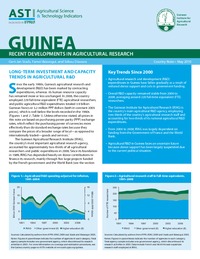Authors:
Stads, Gert-Jan; Béavogui, Famoï; Diawara, Sékou
Year:
2010
Publisher
International Food Policy Research Institute (IFPRI); and Guinean Institute for Agricultural Research (IRAG)
Back to:
During 2000–08, Guinean agricultural staffing levels remained relatively stable. Agricultural R&D expenditures, however, decreased significantly: in 2008, total investments were around 3.9 billion Guinean francs or 3.2 million PPP dollars (in constant 2005 prices), as opposed to 14.0 billion Guinean francs or 11.5 million PPP dollars in 2000. Guinea’s principal agricultural research agency, IRAG, was largely responsible for this decline, given its high dependence on donor funding, particularly through consecutive projects led by the World Bank and the French government. The decline in the country’s overall agricultural R&D, however, was not only due to reduced donor support, but also reflected cuts in government funding. In 2008, only 0.39 percent of Guinea’s AgGDP was invested in agricultural R&D, among the lowest levels recorded in Africa.
Despite the fall in R&D expenditures, two positive developments mark the 2000–08 period: many young IRAG researchers received university training, and the institute was able to develop connectivity to the internet. Nevertheless, Guinea’s agricultural R&D agencies face a bleak future due to the country’s current political climate, which has affected foreign donors’ willingness to support projects in Guinea and made it increasingly difficult for Guinean agencies to secure research funding from other sources. Faced with this situation, the national government will have to considerably increase its financial support to IRAG if the institute is to contribute to achieving food security and reducing poverty. The future of Guinea’s agriculture R&D, and ultimately its agricultural development, will therefore be greatly determined by the country’s political leaders and decisionmakers.

